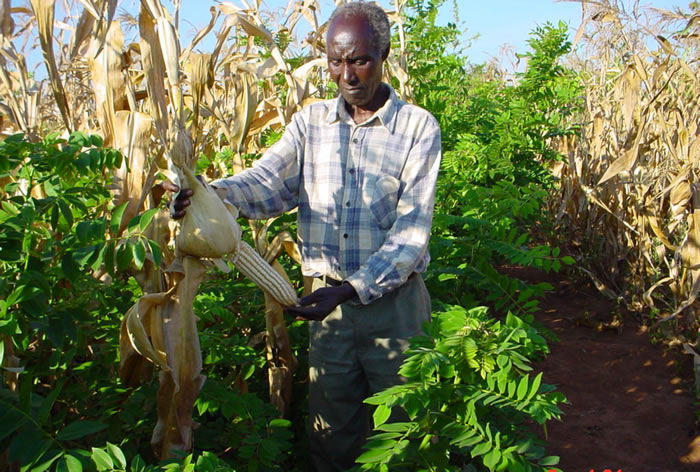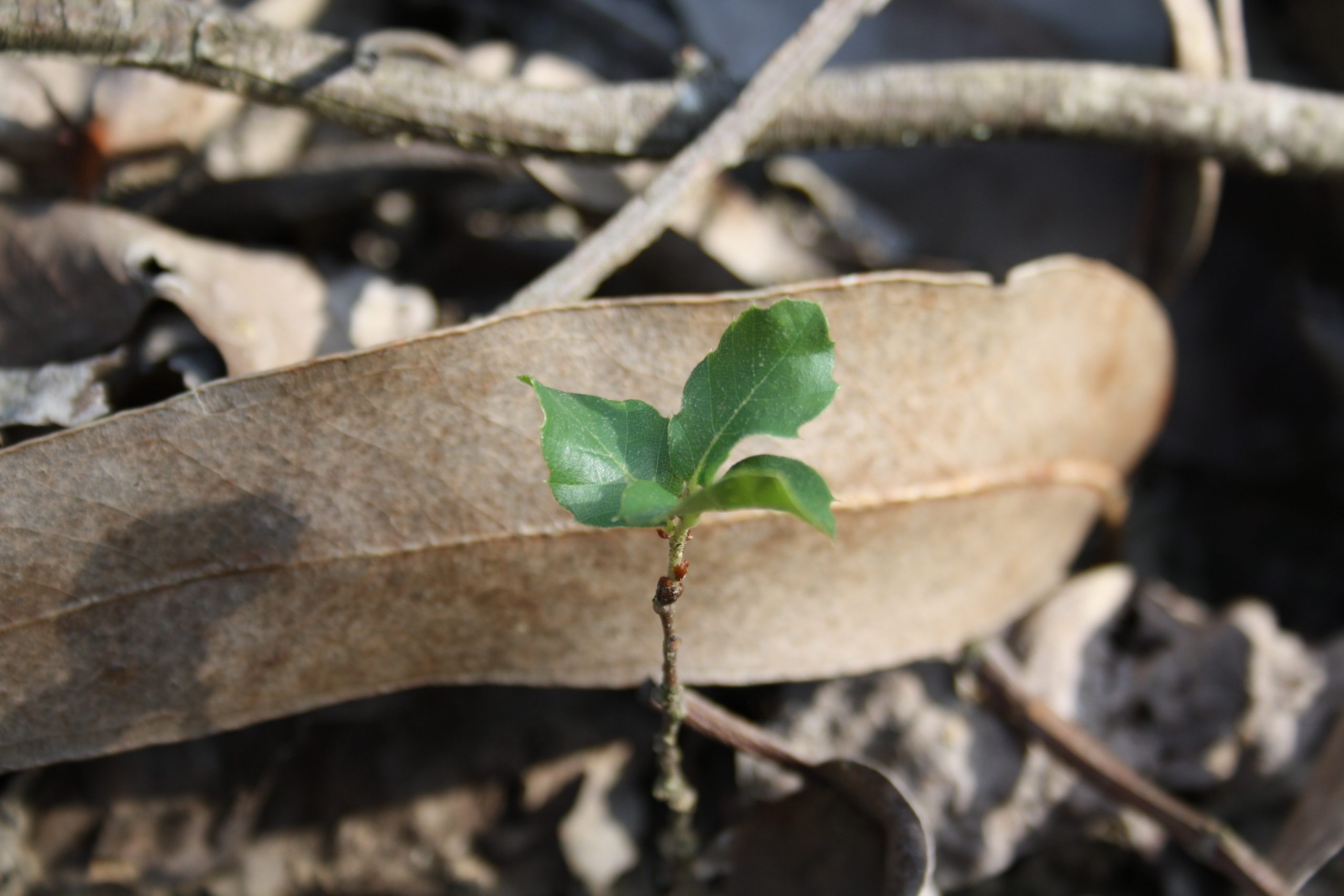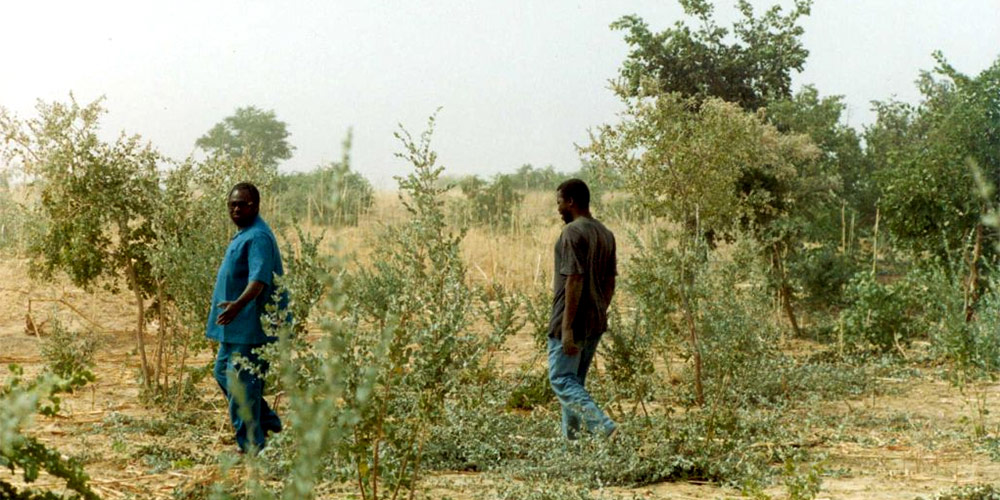Assisted Natural Regeneration (ANR)
Assisted natural regeneration (ANR) is a simple, low-cost forest restoration method that can effectively convert deforested lands of degraded vegetation to more productive forests. It is analogous to farmer-managed natural regeneration, but it is applied to degraded forestlands and rangelands, while FMNR is practiced on croplands.
The method aims to accelerate, rather than replace, natural successional processes by removing or reducing barriers to natural forest regeneration such as soil degradation, competition with weedy species, and recurring disturbances (e.g., fire, grazing, and wood harvesting). Compared to conventional reforestation methods that involve the planting of tree seedlings, ANR offers significant cost advantages because it reduces or eliminates the costs associated with propagating, raising, and planting seedlings. It is most effectively implemented at the landscape level in restoring the protective functions of forests such as watershed protection and soil conservation.
ANR techniques are flexible and allow for the integration of timber production, biodiversity recovery, and the cultivation of crops, fruit trees, and non-timber forest products in the restored forest. Preference for ANR may be given to areas where enrichment planting is carried out, favoring natural and local species used as sources of premium wood or non-timber forest products.
ANR provides a range of benefits:
• a cost-efficient way of regenerating forest,
• provides job opportunities for communities,
• contributes to strengthening biodiversity,
• provides hunting areas and
• increase carbon sequestration and carbon sinks which contribute to climate change mitigation.
Assisted natural regeneration of trees on community forest lands and grasslands has been widely recommended in Asia for at least two decades. Government forest departments have nevertheless been slow to adopt ANR. Forest departments have historically been more focused on planting fast-growing timber trees in plantations, a solution that has its roots in silvicultural engineering paradigms; and it fits more comfortably into forest department experiences and traditions.
Over the past several decades, significant efforts have been made to develop and apply ANR approaches to forest restoration, but much more can be done to implement these methods across millions of hectares.
Knowledge in this area has grown considerably, and it is now apparent that there are additional opportunities to diversify strategies and to expand restoration work. Given the low cost and numerous benefits from ANR, the practice can be accepted and applied widely across the world. Surprisingly, however, ANR techniques are still vastly under-appreciated and under-utilized. This is in part due to the fact that few efforts have been made to promote ANR.
ANR has been promoted in the Philippines, China, and many other Asian countries. The use of ANR in agroforestry systems has also been reported in Brazil. In Zimbabwe, assisted natural regeneration (ANR) of woodlands has been practised since the mid-1980s as an alternative to (or alongside) state- or NGO-sponsored planting of exotic tree species in woodlots. ANR initiatives are undertaken both communally and by individual farmers.
The most dramatic and renowned success with ANR in Africa has been achieved in Shinyanga District in northwestern Tanzania. When President Julius Nyerere visited the Shinyanga Region in 1984 he was shocked by what he saw. Decades of deforestation and inappropriate land management had turned Shinyanga into the ‘Desert of Tanzania.’ The president immediately launched a program to help tens of thousands of smallholders to restore degraded land, and in doing so to significantly improve their incomes.
The project revived the traditional system of land management that emphasized the assisted natural regeneration of trees on degraded forest and grazing lands, which increases the supply of livestock fodder for use during the dry season. When the work began, there were just 600 ha of documented ngitili – enclosed fodder reserves – in the region. There are over 500,000 ha of such reserves, regenerated through the application of ANR.
The ngitili provide fuelwood and building timber as well as livestock fodder. Their rapid expansion has brought about a significant increase in biodiversity. Species that had disappeared decades ago are now returning to the landscape. The economic benefits have also been considerable. One study calculated the total monthly value of benefits derived from the ngitili to be US$14 per person – a significant sum in rural Tanzania.
Farmers were also encouraged to adopt a range of other agroforestry technologies, including the planting of woodlots, fodder banks and fertiliser shrubs. These, too, have yielded considerable environmental and economic benefits. The project was the recipient of the UN Equator Prize in 2001. It holds lessons that could be a basis for models to help to transform lives and landscapes in many other areas in Tanzania, and beyond, which have suffered from serious environmental degradation.
Fertilizer Trees and Shrubs
Improved fallows
The principle of an improved fallow is establishing trees or other perennials in crop fields to regenerate soil fertility during the period when the fields are left fallow. One way of establishing such species is to manipulate the ecological succession of the fallow vegetation. Mexican sunflower (Tithonia diversifolia) is managed in such a way in Mindanao, Philippines, and Austroeupatorium inulaefolium is managed similarly by farmers in Sumatra, Indonesia.
Another alternative is to deliberately introduce soil-building tree species into the field during the cultivation cycle, before the field is fallowed, so that they will grow throughout the fallow period. After 2-3 years the trees are then cut down and the leafy biomass incorporated into the soil as preparations are being made to resume cultivation. The woody material is used as firewood or construction materials.
A variant of this is to maintain a dispersed population of trees in the fields during the cultivation cycle in order to accelerate the restoration of the soil health, as well as to provide useful products. There are many examples of this practice in the Asia-Pacific region, involving both leguminous and non-leguminous soil-improving species. These include Leucaena leucocephala, as used in a number of fallow-rotation systems in Indonesia and the Philippines, Sesbania grandiflora and other Sesbania species, and Alnus nepalensis in northeast India, southwest China and northern Myanmar. A prominent and very similar example from central America is the quesungual farming system.
Extension programmes on improved fallows have been implemented in western Kenya and eastern Zambia, where these systems had received considerable research attention. Studies later showed that there was considerable adoption by Zambian farmers, where land availability was more abundant and fallowing was practiced. However, in western Kenya there was only limited adoption because the practice fallowing was rapidly disappearing in the farming systems of that area, because of population pressures and decreasing farm size.
Alley cropping
The development of practices to integrate soil-regenerating trees into continuously cropped land began in earnest in the 1980s. The classic model of these systems was alley cropping, which involved densely planted rows (or double rows) of nitrogen-fixing trees spaced at intervals in crop fields. Annual crops were then cultivated in the alleyways.
The concept was inspired by the widespread use of such systems on the island of Flores in Indonesia, which continues today, and by farmers in southeastern Nigeria. The trees are pruned frequently, and the biomass is spread in the cropped area, and either incorporated into the soil during land preparation, or used as a surface mulch.
These systems often succeeded in raising and sustaining higher crop yields, particularly on infertile or degraded soils. Early results stimulated the development of a continental network in Africa that tested the alley-cropping principle quite widely. This included various permutations of fast-growing nitrogen-fixing trees and pruning regimes, and the investigation of their effects on crop yields and systems sustainability. Considerable work was also done on alley cropping in Asia and Latin America.
However, when serious extension programmes were implemented to scale-up the practice, it became apparent that the labour required to maintain the tree hedgerows was often considered too onerous by many smallholder farmers. To date, adoption of the practice has been limited, other than at the locations mentioned above, where it was practiced traditionally.
One important spinoff of the extensive work on hedgerow intercropping, however, was the development of the practice of deploying natural vegetative strips as an effective soil- and water-conservation system for sloping croplands. This simple and effective technology was developed from observations of indigenous practices. It involves laying out contour lines on the slope of the fields, and then allowing natural vegetation (often native grasses) to regenerate and form a protective barrier against soil erosion. The practice has now been integrated into smallholder extension programmes in a number of Asian and African countries.
We now turn to the options for sustainable land regeneration where shifting cultivation has been replaced by continuous cropping, and where declining soil fertility is a serious threat to smallholder livelihoods.
Coppiced shrubs in food crop fields
A second cycle of research was initiated in the mid-1990s by ICRAF in Malawi. The alley-cropping model was modified to reduce the labour burden while still taking advantage of the biofertilizer and soil-regenerating benefits of fast-growing fertilizer trees. The most successful model involved planting fertilizer trees such as Gliricidia sepium at a spacing of 1m x 2m throughout maize fields, and then pruning the plants two or three times per year, leaving a short coppiced stump about 25 to 30cm tall.

Maize farmer in Malawi with gliricidia shrubs intercropped in his maize field.
These coppiced fertilizer-tree systems demonstrated the ability to produce substantially higher maize yields, often double or triple the yields obtained without the shrubs. Their success led to the development of Malawi’s National Agroforestry Food Security Programme, which was launched in 2006. That programme also promoted the practice of relay-planting fast-growing woody perennials in maize crops, which would be incorporated into the soil at the end of the following dry season, having produced a store of nitrogen-rich biomass for application as biofertilizer.
A high density of trees per hectare is recommended. Thus, the labour requirements in managing the abundant woody biomass produced during the dry season are also considerable. The Malawi experience has shown that the practice may be best-suited to small farms of less than 1 hectare that have surplus family labour during the dry season, or for use by farmers that are obtaining cash income from the sale of the abundant fuel wood that is produced.
The concepts underlying these innovations have wide applicability, and they deserve more development attention.
Recent efforts to use the wood produced by the coppiced shrubs as a source of fuel for electrical power generation in Sri Lanka have shown that farmers are further stimulated to practice these evergreen agriculture systems by the cash that they earn from the shrubs (see the section on EverGreen Energy).
Fertilizer tree technologies (FTTs) have been scaled-up so far mainly through conventional extension programs. However, interest is rapidly developing to further incentivize agroforestry investments on the farm by linking them to government fertilizer subsidy programs. By linking the adoption of fertilizer trees with fertilizer subsidies, countries can provide for long-term sustainability in fertilizer nutrient supply at reduced cost, and build up soil health as the basis for sustained yields and improved fertilizer response efficiency. This will enhance farmer investment in the purchase of inorganic fertilizer.
Furthermore, most of the mineral fertilizer received by farmers is usually applied over a far bigger area than that recommended by the extension agents resulting in mineral fertilizer application rates as low as a quarter of the recommended rates. In such situations fertilizer trees complement these small doses of mineral fertilizers.
The establishment of these biological fertilizer factories on the farm will enhance the impact of the input subsidies. Farmers would be encouraged to produce more of the nitrogen required by their crops on their own farms, increasing and sustaining their crop yields and improving their soils. This can foster a gradual shift of investments from short-term fertilizer subsidies to sustainable on-farm fertility regeneration, opening up a subsidy to sustainability pathway.
A successful pilot project to scale-up fertilizer tree technologies is currently being implemented in Malawi that involves 10,000 small-scale farmers. This is part of the Malawi’s National Agroforestry Food Security Programme that has been implemented in districts across the country for many years. Plans are underway to expand the programme targeting up to 30,000 farmers.
In Zambia, fertilizer tree technologies have been extended on a large scale through the Conservation Farming Unit’s extension programme, and through private sector-sponsored extension programmes, particularly in Eastern Province. Research and extension programmes on fertilizer tree technologies have also been promoted in Mozambique, Rwanda, Tanzania, Kenya and Ethiopia. These provide the base and experience for creating the appropriate models for connecting with the FSPs in these countries.
The Ministers of the Common Market for Eastern and Southern Africa (COMESA) discussed the issue at their meeting in Lusaka in February, 2015, and approved the recommendation that COMESA strengthen awareness among member countries of the major economic and financial advantages of scaling-up fertilizer tree technologies, and develop an initiative to assist countries to share their experiences in developing subsidy to sustainability pathways that will significantly enhance the impact and welfare benefits of input subsidy programs.

